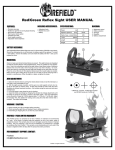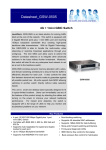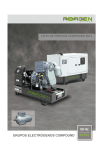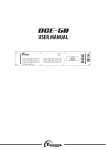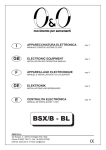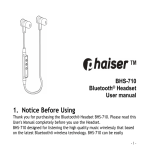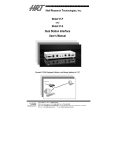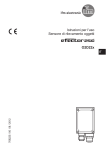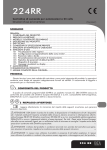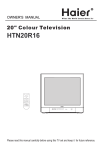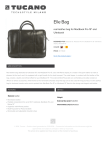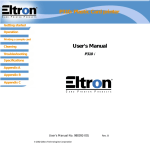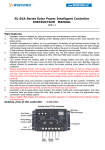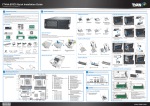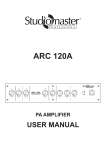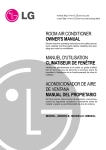Download User Manual - Solar Charge Controller
Transcript
Maximum Power Point Tracking Series Intelligent Wireless all-in-one with step-up LED driver MPPT solar charge controller MPC2415/2410 User Manual MPC2410 Model MPC2415 Battery voltage 12V 24V 12V 24V Max.solar input power 130W 260W 200W 400W Max.solar input voltage 17V~60V 34V~60V 17V~60V 34V~60V <75V Max.Voc of solar panel Max.charging current 15A 10A Max.LED power 60W 120W 80W 160W The No. Of LED in series 5~18 10~18 5~18 10~18 LED output voltage 15V~60V 30V~60V 15V~60V 30V~60V Dear users: Thank you very much for choosing our products! Please read the manual carefully before using our controllers. Material Code:1.1.24.01423 Version: 1.01 The above information is subject to change without prior notice. Features Faceplate Support both lead acid(Gel included) and lithium battery both for 12V and 24V system. Adopts MPPT charging method, which supports the Voc of solar panel≤75V. With step-up constant current source for output, which can drive 18 LEDs in series. Multi-crest MPPT tech, adapts to the solar panel which is under shadow or partly damaged. 4 levels dimming design(including morning lighting). IR remote control: for parameter setting, parameter reading and historical data checking. Auto identify day/night. Very low dormancy loss: 0.06W. Protections: IP68, over charge/over discharge protection, reverse connection protection, reverse charging protection, over load/over current protection, short circuit / open circuit protection, over temperature protection, TVS lighting protection. Brown/Load positive IR receiver Red/Battery positive IR transmitter Instructions Black/Share negative The solar panel voltage may exceeds human safety voltage, pls use insulating tools while operation. 2. Battery indicator Temperature sensor PV indicator Pls wiring correctly, do not wrong wiring, reverse connection or it will be short circuit. Though our controller have all the protections, but it will do harm to our controller and your solar battery. 3. Load indicator Size The wiring of the whole system will be varies, pls pay attention to insulation, wrap up each wire after it’s connected. 4. Φ3.5 Φ3.5 Our MPPT controller is designed for the VI curve of solar panel, it’s not suitable for constant voltage DC power supply. 142 102 dissipated place. 88.33 114 74 5. Choose the wires which is of enough capacity, to avoid big loss on the wiring. 6. Our controller will emit heat during operation, so pls install it in ventilated and heat 24.47 1. Blue/PV positive 7. Fully charged of the battery is very important, pls fully charge the battery once a monty, or the battery will be damaged. 82.33 8. Please do not dip the controller into the corrosive liquid otherwise the controller will be damaged and release harmful gas. 9. Because the battery stores lots of energy, do not allow the battery short circuit in any case. We suggest tandem connect a fuse on the battery. 10. The battery may release combustible gas, please far away from the spark. 11. Ensure the children are far away from battery and controller. 12. Please abide by the battery manufacturer’s safety suggestion. 82.33 MPC2415 Dimension as below MPC2410 Dimension as below Overall dimensions:142x88.33x24.47(mm) Overall dimensions:114x88.33x24.47(mm) Installation dimensions:102x82.33(mm) Installation dimensions:74x82.33(mm) Installation aperture:Φ3.5(mm) Installation aperture:Φ3.5(mm) 5. Connection③—Red/Battery positive: after connect correct the middle indicator Installation will open.The red indicator instead of the lead acid battery, the green indicatory instead of the lithium battery, with two function can check whether the load is 1. Controller fixed: 1st type: Fixed the controller in the case by M3 screw. 2nd type: Fixed the controller in the holder inside of the pole by the screw or iron wire. Pls protect against freezing ,flooding and wire damage. 2. Cable use: connected correct or not:1.Press the "test" key, the load indicator and LED light will be on. Press the test key again can test the light by different power(100%-70%-30%-0%). 2. If without remote control, can remove solar panel and waiting after light control delay time(setting by remote control before, 1mini default), Load indicator and LED light both will be on. Attention: use the electrical tape to hold it tight. a. Pls use the cable which ampere density less than 4A/mm²; Besides, if the battery cable more than 2m,pls calculate the ampere density( 8/length) A/mm², Unit: m. b. Do not strip the insulation of the battery cable before connect to the controller to avoid cause the battery short circuit. c. Use the suitable length cable which can decrease the E-loss. 3. Connection①—Black/Share negative: connect the share negative with battery, pv and battery’s negative; Connect the negative to ground if request. Attention: use the electrical tape to hold it tight. 3 图C 6. Connection④—Blue/PV positive: Solar panel voltage might be exceed 36V(safe voltage), attended prevent electric shock. The solar panel connected ok, PV indicator will be on after 10s later means that in charging. Now can use the Ampere meter to test 1 1 1 the charging current is normal or not. Attention: use the electrical tape to hold it tight. 图A 4. Connection②—Brown/Load positive: Attention: use the electrical tape to hold it tight. 4 图D The mentioned above are the connection suggestion which consider about the system safety and easy operation. If use other connection sequence, controller will not damage 2 but will showed different indication. When connected pls consider about the system safety. For example, just connected the solar panel under the lead acid battery mode, three indicator will be on in turn until connecting the battery. 图B 2. MPC controller with four section working mode, the 4th section is morning light time and Working Status Indication Specification each section can be adjust range from 0 to 15hours, power is from 0% to 100%, the adjustment unit is 1hours and 10% power. This four section can be setting and combine Serial Number Indicating Status Normally on. Slow flash. (light for 1s,off for 1s,the cycle is 2s) Single flash. State of charge Charge at Max. Power. indication Fast flash. Float charging. ③ Light is working at all night but delay 2hours start: the first section”2hours,0% Equalizing charge. ④ Light is open but delay 2hours start and then running 5hours and light again and morning light time is 0hour. power”, other sections the working time setting should be more than night length. 2hours before dawn : the first section”2hours,0% power”, 2nd and 3rd sections the Double flash. total working time setting is 5hours and morning light section(the 4th section) setting Current limited charging. reclose for 1.7s,the cycle is 2s) Off Normally on. Battery Slow flash. indication (light for 1s, off for 1s, the cycle is 2s) Fast flash. (light for 0.1s, off for 0.1s, the cycle is 0.2s) Normally on. Slow flash. (light for 1s, off for 1s, the cycle is 2s) Fast flash. (light for 0.1s, off for 0.1s, the cycle is 0.2s) Other indication 2hours. ⑤ Light is working 4hours at night and morning light 2hours: the first three section Solar panel voltage too low can not charging. Red light: Lead acid battery; Green light: lithium battery indication night length. ② Light is working 5hours at night: the first three section total working time is 5hours (light for 0.1s,off for 0.1s,the cycle is 0.2s) (light for 0.1s,off for 0.1s,reopen for 0.1s, Load ① Light is working all night: four section working time should be setting more than Boost charging. (light for 0.1s,off for 1.9s,the cycle is 2s) Charging to different mode, for example: total working time is 4hours and morning light time(the 4th section) is 2hours. ⑥ Moring light mode working 3hours before dawn : the first three section total working time is 0hour and morning light time(the 4th section) is 3hours. The battery voltage is normal. The battery is over discharged. 100 70 50 30 The battery is over voltage. Light Off Load open Open circuit.(Load) Short circuit.(Load) Off Load closed Three indicator were opened in turn and System only connect with solar circle. panel. Three indicator were closed. Without power or in sleeping mode. Working Time 1 Parameter:0~15h Default value:4h Parameter:0~100% Default value:100% Working Time 2 Parameter:0~15h Default value:0h Parameter:0~100% Default value:70% Working Time 3 Parameter:0~15h Default value:4h Parameter:0~100% Default value:50% Morning Light Time 3 Parameter:0~15h Default value:0h Parameter:0~100% Default value:30% 3. LED Intelligent Power Control:While customer open the “Intelligent power” mode, the controller will enter to the intelligent power control mode, The LED load power will adjust automatically according to the battery power. The working time and load power preset Load Working Mode Specification 1. Light control/Close the load: MPC controller can recognize night and open the load ; And it also can recognize day and closed the light even though it does not reach to the before is still valid; system will compare with the automatically power and the preset power, and choose the smaller one as the load output power. For example: when the battery power is 50%,intelligent power mode calculate the load power is 60%,if customer preset the load power as 100%,the system will choose working time set in advance. Solar panel voltage less than light control voltage recognize 60% as load power. If customer preset the load power as 20%, the system will choose as night. Solar panel voltage more than “light control voltage+1V” recognize as day. 20% as load power. Load power Load power & Batter y capacity 6. Aim at the controller and press ”State” key to read the historical data including running 110% 100% 90% 80% 70% 60% 50% 40% 30% 20% 10% 0% date,over-discharging times,full charging times and the change data of battery voltage within 7days. 7. Aim at the controller and press ”Test” key to test the light is on or off. 8. Press the ”BackL” key, the backlight will be open which suitable to use at night. 9. Press the ” Light” key, the light in front of the remote control will be open which suitable 0% % 5% % 10 15 % % % % 20 25 30 % % % % 35 40 45 50 55 % % 60 65 % % % 70 75 80 % % % 85 90 95 10 0% to use at night. 10. The remote control will enter sleep mode when without use after 1mins. Battery capacity 4. Test mode: Use for testing no matter at night or on day time. Press the test key,the LED indicator and the LED light will open, press the test key again the power of the led light will change with four sections:100% 70% 30% 0% 100%…Without any operation about 1min,controller will exit the test mode. Energy saving and sleep mode 1. Energy saving mode:if no need lighting, controller will enter the energy saving mode. The second days will exit the energy saving mode after sunshine. 2. Sleeping mode: Battery over-discharge 1mni later or in short circuit protection 6times continuous will enter sleeping mode and the three indicators will be closed. The second day when battery is charging ,controller will exit sleeping mode. 3. In sleeping mode, remote control can awake the controller temporary and will enter sleeping mode again 1min later. The system has been running many days and found that three indicator closed, it might be in sleeping mode can try to awake by remote control. Remote control setting declare (Setting description pls refer to the remote control specification) 1. The remote control model(Use for MPC):SR-CU-M 2. Press any key to start the remote control. Long press”+” and “Light” 3s can lock/unlock the remote control;When remote control lock, can not read and setting data. 3. Aim at the controller and press ”Param” key(parameter) can read the data from controller. A long voice “beep” means that success. Three times “beep-beep-beep” voice means that failure. 4. Press”+”,”-”,”Set” key can setting parameter. Remark:Pls choose the battery type firstly because the data setting will be different. 5. Aim at the controller and press ”Send” key to send and setting controller data. The remote control can keep two group data including Lead-acid battery and Lithium battery. When change the battery type, the data will change according to the battery type what u choose, pls setting the battery type firstly. Parameter Typical efficiency diagram Parameter Name Value Model MPC2410 Supported battery MPC2415 Lead acid battery(gel included) and lithium battery Battery voltage 12V 12V 24V Battery voltage range 24V Solar panel power Solar input voltage Max load power LED in series(S) 260W 34V~60V 200W 17V~60V 400W 34V~60V 60W 5~18 120W 10~18 80W 5~18 160W 10~18 15V~60V 30V~60V 15V~60V 30V~60V ≤95% ≤97% ≤95% ≤97% No-load loss ≤0.55W/normally operation,≤0.32W/energy saving mode, ≤0.06W/sleep mode Voc of solar panel <75V >99% 15.5V;×2/24V Limited Charge voltage Float charge voltage Temperature compansation Charging prohibited under 0℃ Charging method Over charge voltage Over-charge recover voltage For lithium batter y Boost charge time For lead acid batter y Over voltage protection Boost charge voltage 13.3V battery,PV peak voltage 17V,34V,60V) (Pic 1) Lithium battery only 2. Controller energy conversion efficiency(Conditions: MPC2415,MPPT charging, 130W 17V~60V MPPT tracking efficiency 17.0V;×2/24V (Equalizing charge voltage + 0.4V);×2/24V(25℃) 1 Hour 30 Days 7.5V~15.5V;×2/24V(25℃) 4 Hour 7.5V~15.5V;×2/24V(25℃) √ <Yes, No> 13.8V √ Invalid setting <0、1> 7.5V~15.5V;×2/24V √ 14.6V 7.5V~15.5V;×2/24V √ 13.6V √ 11.0V √ 900mA 7.5V~15.5V;×2/24V 7.5V~15.5V;×2/24V output ,13.3V battery,5 pcs /10 pcs/18pcs LEDs in series,80Wmax) (Pic 3) 4. Controller energy conversion efficiency(Conditions: MPC2415,constant current output ,26.6V battery, 10 pcs/18pcs LEDs in series,160Wmax) (Pic 4) ±3% or ±30mA Light control voltage 5V~15V;×2/24V √ 10V Light open time delay 1~50min √ 1min 1min -40℃ ~ +60℃; Light close time delay Working temperature Internal overtemperature protection 3. Controller energy conversion efficiency(Conditions: MPC2415,constant current 12.6V 70~5600 mA 70~4200 mA Output current accuracy (Pic 2) 14.4V No Over-discharge recover voltage Output current range (Pic 1) √ -3.0mV/℃/2V Over-discharge voltage 70℃~85℃decrease the power step by step, when over 85℃, load or charing will be off. 390g 490g Product dimension 114×88.3×24.5(mm) 142×88.3×24.5(mm) Installation dimension 74×82.3(mm) , Φ3.5 102×82.3(mm),Φ3.5 Protection 1.IP68 degree;2. PV and Battery reverse connection;4. internal overheat;5.PV over voltage, short circuit; 6.charge,discharge over load; 7.Anti converse charge at night;8.TVS protection to PV. 9. Load short circuit, open circuit ;10. Battery open circuit Weight 1. Controller energy conversion efficiency (Conditions: MPC2415,MPPT charging, 26.6V battery,PV peak voltage 34V,60V) (Pic 2) Circuit efficiency Output voltage range Equalizing charge interval √ 15A 10A Limited charge current Equalizing charge time Default value 7V~36V Charge current Equalizing charge voltage Adjustability Remark: 1.The real mini output voltage is higher than currently battery voltage about 1V. 2. The real mini output voltage is limited by mini output current 70mA and mini output voltage. (Pic 3) (Pic 4) The MPPT tracing efficiency test (under the shaded condition) 1. There’s shadow in the middle of PV module, the tracing efficiency is 96.34%. 3. Simulate tree shade covered PV module, the tracing efficiency is 99.88% 2. There’s shadow at the top left corner of PV module, the tracing efficiency is 99.70%. 4. There’s wide-range shadow covered PV module, the tracing efficiency is 98.41% MPPT Charging Algorithm Instruction The full name of the MPPT is maximum power point Current Working point of the general controller tracking. It is an advanced charging way which could Maximum power point detect the real-time power of the solar panel and the maximum power point of the I-V curve that makes the highest battery charging efficiency. Contrast with the traditional PWM controller, MPPT controller could play a maximum power of the solar panel so that a larger charging current could be supplied. Generally speaking, the MPPT controller’s energy utilization efficiency is 12.0V 17.5V 22.0V Voltage 15%~20% higher than PWM controller. The voltage of the solar panel is about 12V when General controller is charging while the highest voltage of the solar panel is about 17V, so it doesn’t play the largest power of the solar panel. MPPT controller overcome this problem by adjusting the input current and voltage constantly to realize the largest input power. Meanwhile, the maximum power point will change due to the surrounding temperature and sunshine condition. MPPT controller will adjust the parameter constantly according to different conditions to make the system working in the largest power point. As a charging stage, MPPT can’t be used alone. It must be combined with ascending charge, floating charge, equalizing charge to complete the battery charge. The controller will judge the battery voltage before working. If the battery voltage is higher than 13.2V(*2/24V), the controller will judge the battery working as full charge state, then the controller will enter into floating charge stage, except equalizing charge or charge hint. When the battery’s initial charging voltage is under13.2V (*2/24V), the charging process is: MPPT-equalizing charge-boost voltage charge-floating charge. The span of equalizing charge is 1 hour, ascending charge is 4 hour, and equalizing charge interval is 30 days. Charging curve is as below: Voltage/Current Equalizing charging 1 hour 14.6V 14.4V Battery voltage(fully charged) Battery voltage(not fully charged) Charge current Ascending charging 4 hours 13.8V 13.2V Floating charging till night Voltage 12.0V Current 1.5A/ 100AH MPPT charging stage Dawn Equalizing/ascending Floating charging stage charging stage Daytime Night Time








